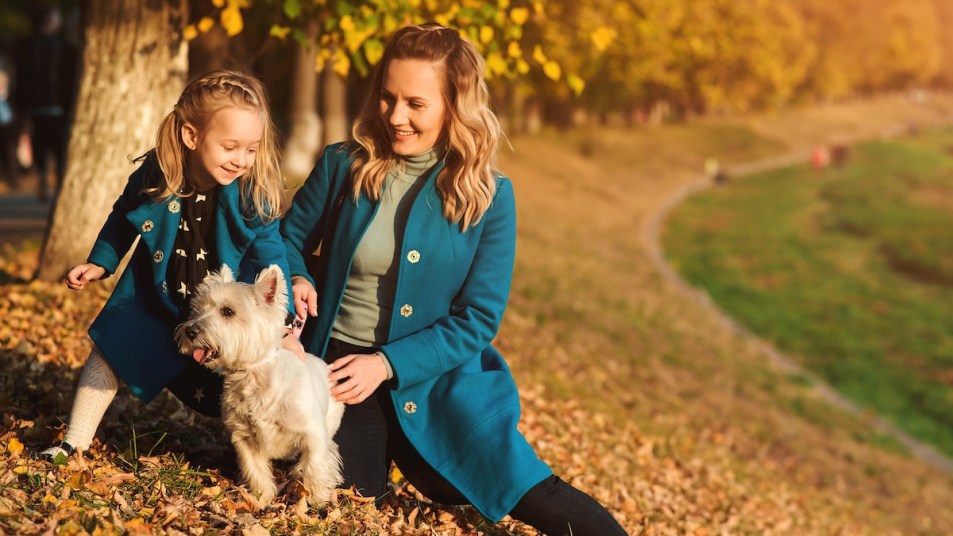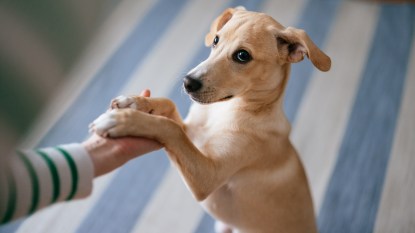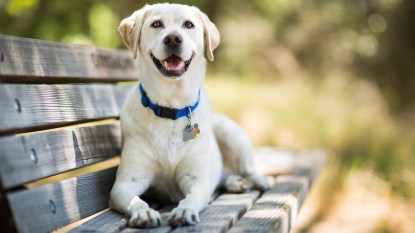To Pet or Not to Pet? How To Keep Interactions Between Kids and Dogs Safe
Think before you pet.

Dog attacks are reportedly on the rise, and some parents may be wondering how to keep interactions between kids and dogs safe — and make sure that everyone is happy.
Dog attacks involving children often involve the family dog or a dog known to the child. While we need more research around the events leading to these attacks, they’re likely a combination of a series of unfortunate events, rather than an inherently “bad” dog. After all, any dog can bite.
Every pet and every child interaction is different, but here we discuss some general tips for good interactions and outcomes.
Pat, Pet, Pause
Just as you wouldn’t run up and hug a stranger in the street, you shouldn’t do so with a dog, either. It’s vital children learn how to approach dogs safely. They should always stop a few feet from a dog they want to pet and ask the responsible handler for permission, before also asking the dog.
You can ask dogs if they want a pat by remembering the phrase, “pat, pet, pause.”
- Pat. Pat your leg to encourage a dog to come over.
- Pet. If the dog comes to say “hi!,” give them a gentle pat on the shoulder or side. Never pet a dog on the head (dogs hate it!). Stand side-on so the dog can always move away.
- Pause. Stop after three pats (or three seconds), and wait. If the dog reconnects (leans in or bumps your hand) then pet again for another three seconds. If the dog remains still, leans away, or moves away, they don’t want to be patted at that moment — but you can try again later.
Children and adults alike should pat, pet, pause in every interaction with a dog — even the family dog. And interactions should be short, supervised and managed carefully.
Not all dogs are used to kids. Some may be very social and friendly, but not know how to interact with children safely.
Keep social, friendly dogs on a leash or use a playpen (or fence) to keep both dogs and children safe. Use lots of tasty treats to reinforce a dog’s good behavior for keeping four paws on the floor.
Things can escalate quickly if children get excited or if a dog starts zooming around. Keeping interactions short (and supervised) reduces the chance of somebody being hurt.
Be extra careful with very large or heavy breeds, as young children can get knocked over easily.
Learn To Speak Dog
Dogs communicate well, if we learn to listen. They show signs of fear by moving away, cowering, or tucking their tail between their legs. If they flick their ears back, turn their head away, or close their mouths it means they’re not comfortable. Miss these signs and a dog might growl or bite.
A wagging tail doesn’t always mean a dog is happy — “good” wags are mid-height, slow(ish), with a relaxed body. Dogs, though, also wag high when tense, or very low when extremely nervous (both signs to say “hi!” from a distance).
Research shows children under 6 years old find it difficult to identify dog body language — signs of fear or stress — although older children can increase this knowledge with education. It’s up to adults to supervise, watch both dog and child closely, and stop the interaction if either isn’t coping.
It’s important to never punish a dog for growling. Growling is a serious signal (especially around children) and needs to be addressed quickly with careful management and training. However, it is clear communication on a dog’s part. Punishing a growl might silence your pet, but the underlying discomfort (or fear) behind the growl will still be there. This means a dog might not give any warning before biting.
Ignoring signs of stress or fear, or finding it funny, puts everybody at risk. Stop troublesome interactions immediately and contact a qualified, experienced dog trainer if needed.
Remember that a dog in his bed, or eating, needs his own space. These are a dog’s safe zone — kids should not approach for any reason.
Kids also need their own “safe” space or time away from the dogs (for example, in their bedroom).
Also respect the space of dogs you see in public. Just because a dog is outdoors doesn’t mean it’s comfortable with strangers approaching. And even if a dog is walking with children, they may not want to meet new children.
If the dog is tied up in front of a shop (or you can’t find their parent), wait to say hello another day.
Sometimes pet parents feel pressure to ensure their dog says “hi!” to children, but always listen to the animal, and feel empowered to say no to pats from children. It won’t hurt to miss this one interaction, and the experience will serve as a learning opportunity for kids to respect the space of animals.
A version of this article appeared in our partner magazine, Inside Your Dog’s Mind.













